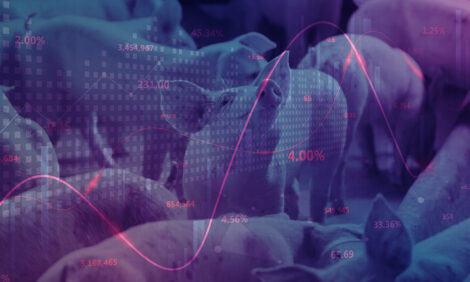



Romania Pork Industry Overview, August 2004
By USDA, Foreign Agricultural Service - This article provides the pork industry data from the USDA FAS Livestock and Products Annual 2004 report for Romania. A link to the full report is also provided. The full report includes all the tabular data which we have omitted from this article.Report Highlights
Swine inventories in 2004 have slightly diminished compared to the previous year, after the very severe drought in the summer of 2003, which dramatically raised feed prices. Although live cattle are a major agricultural export item of Romania, the country remains a net importer for both beef and pork, including from US. The current production subsidies are anticipated to result in some recovery of the livestock sector in 2005, evolution to which the upward trend in consumption prices is also contributing.
Production
Romania’s swine inventories reached, in the beginning of the MY2004, 5.14 million heads,
representing a 1.7 percent increase from the previous year, although sow stocks were 8
percent down. This situation (attributed to the extremely severe drought that affected the
grain and feed sector in 2003) partly explains the decline in livestock numbers in the first the
first half of the year 2004, with over 400,000 hogs less than in January-June 2003, and likely
to continue shrinking swine herds until the end of December. However, a wide range of
governmental programs meant to support livestock population and production (described in
more detail below), if not discontinued after the November 2004 elections, are expected to
result in some recovery in 2005. The majority of this swine population (a steady 75 percent)
is held in individual households, while only 23 percent of the animals are bred in large farms
(of over 3,000 commercial hogs). Nonetheless, some new commercial operations, developed
by private investors, are emerging. As an example, the largest Romanian (and one of the
largest by worldwide standards) integrated operation, located the western part of the
country, has been recently acquired by a major multinational.
Cattle inventory was steady throughout 2003 and no significant changes are expected by the
end of 2004. A trait of the bovine sector in Romania is that there are no differences in feed
ration formulation for dairy cows versus beef cows. In fact, there are no statistical registrations
to make the distinction between the two categories of animals. Cattle and calves on feed stood
at roughly 2.9 million heads in the beginning of 2004 and some increase was registered during
the first half of the year (in absolute terms, with 2,000 animals) as against the same period of
2003. Even though bovine growers are eligible for different GOR subsidy schemes, recovery in
the sector is very slow, due to both the long production cycle and the structural deficiencies
that are characteristic to the Romanian agriculture, where market-oriented operations coexist
with small subsidence farms, requiring deep restructuring. This means that most production
continues to come from small farms. Households holding 1-2 cows count for the majority of
dairy cows inventories (about 80 percent). Less than 40 percent of the domestic beef
production (i.e., 142,000 MT, on a liveweight basis) goes to meat processing units, while 26
percent are self-consumed in rural households and the remaining 35 percent supplied to the
retail market.
We anticipate that pig meat production in 2004 will be down by some 5 percent, because of a
drop in the number of animals slaughtered, although this may be partly compensated by
some increases in the average carcass weight. For the first half of the year, the official
Ministry of Agriculture statistics show that the average liveweight at slaughtering was 105 KG
(versus 103 KG in January-June 2003) for hogs and, respectively, 359 KG (versus 346 KG)
for bovine cattle, reportedly attributed to improved feed and forage practices at farm level.
In 2004, only about 32 percent of domestic pork supply was delivered to processors, while
the share of self-consumption remained very high, at about 60 percent, with the balance
directly sold on the retail market. This is insufficient to cover the local processing demand, so
that significant amounts of pork cuts (almost balancing the domestic supplies) are annually
imported.
It is generally assessed that after Romania will become an EU member (optimistically
scheduled for 2007), only the few farms currently equipped with competitive technologies
will remain operational. The recently issued EU position paper, referring to the completion of
negations on agriculture with Romania, stressed the importance of the accession
preparations considering all aspects of food safety along the production chain, including
primary production, the production of animal feed and consumer safety. Although the EU
meat industry is subject to strict sanitary regulations, according to the document, Romania
was granted a transition period until December 31, 2009 for modernizing and re-vamping its
slaughtering and meat processing units, in compliance with the Community requirements,
while products from establishments subject to transitional arrangements will not be sold to
other Member States and will be clearly identified. In absolute numbers, this is how the
Romanian industry is foreseen to look in 2010: out of the existing meat processing capacity
(totaling 728,000 MT/year for slaughtering and, respectively, 777,000 MT/year strictly for
processing), about 30 percent will be shut down. This means that, out of the total of 561
slaughterhouses registered in 2004, only 4 are EU-requirement compliant, 14 are to be
revamped by 2007, 20 will be modernized by 2010, while the remaining 523 are listed to be
closed. A similar situation is in processing1: 5 plants are EU-compliant, 52 will be revamped
by 2007, 17 by 2010, while 507 are likely to be shut down.
Consumption
Per capita meat consumption in Romania is about half of the EU average (92 KG). Romanians
show a strong preference for pork (Graph 1), though chicken meat’s share in the average
diet is increasing.
Animal protein intake continues to be relatively low in the consumption pattern (about 19
percent), although we forecast an increase in 2005, in tandem with higher incomes resulting
from a stable economic growth (of an average of 5 percent over the past 4 years and
another 5.3 forecast for 2005). Continued strong consumption growth has been one of the
driving factors to GDP expansion, but this translated less in food consumption in the
beginning of the 5-year economic growth period. The expenditure structure was heavily
influenced by the fact that population started receiving access to individual loans and thus
preferred to buy dwellings or household durable goods.
Production of processed meat products was in 2003 only 155,430 MT, because of the
relatively modest domestic consumption (of only 8-9 KG/year/capita). Meat and meat
products consumption pattern reveal some seasonality, with peak periods in May-June and
September-October.
The estimated meat products market reached in 2003 EUR 300 million. In terms of
geographical distribution, the largest processors are located in the southern Romania.
More than half of the meat-processed products are sold in bulk, while domestic products are
preferred to the imported ones. Romanian consumers prefer “tasty” fresh products and,
though fat content and additives are not yet an issue, there is a trend towards buying more
expensive higher quality products.
Consumers are not devoted to a single brand, but product availability (i.e., good distribution
through supermarkets and smaller points of sale) plus an acceptable price/quality ratio are
factors that influence consumption of a certain brand.
Currently, the market is in the growing phase. The top five meat-processing companies
account for roughly 40 percent of the market, while consolidation is expected to continue.
Important foreign players are expected to enter, because of the still relatively low labor cost
and the proximity of the country to EU and Russia. Lately, due to the rapid appreciation of
pork prices in Europe and US, as well as the limited domestic supplies, many producers
reportedly turned to black market operations, which, according to the estimates of the meat
processing association, reached an alarming 60 percent of the total market.
Though the meat and meat processed products market are not foreseen to expand rapidly in
terms of volume in the near future, the market value is expected to raise, since domestic
consumers are shifting to higher value added and quality products. As of today,
circumstances are quite favorable to multinationals to make takeover bids for local producers and, in fact, Polish, German and Dutch producers have expressed interest in investing in the
Romanian meat processing industry.
Trade
For both live swine animals and pork Romania remains a net importer. Up to May 2004, when
Poland, Hungary and the Czech Republic joined the EU, these were the most important
sources for swine/pork products, especially because their subsidized exports were able to
successfully compete with the local suppliers. In an attempt to protect the domestic market
from cheap Polish and Hungarian sales of swine meat, safeguard measures against the two
countries were introduced in July 2003, respectively March 2004, until they became full EU
members. However, the interest of these former CEFTA trading partners to export to
Romania may diminish in the short run, as reportedly they currently seek opportunities in
Western Europe, a “market with an unquenchable appetite”. Thus, FAS Bucharest forecasts
that, for the balance of the year, as well as for 2005, pork imports from EU will diminish.
Demand for swine meat, nonetheless, remains high in Romania and thus US can be very
competitive. Using the duty suspension for pork cuts (Table 1), US pork exporters started
identifying some opportunities, especially shoulder cuts, trimmings and offal used in
processing industry. In 2003, 2240 MT of pork cuts were originated from US, while another
1500 came in January-May 2004.
Romania is not allowed to export swine animals/meat to either EU or US, because it has not
countrywide discontinued inoculating against classical swine fever. Nonetheless, the
veterinary authorities are strictly implementing a program agreed with EU, which started in
August 2003, and which would give Romania permission to export pork from 2006.
Prices
In the first half of 2004 swine meat prices have rapidly appreciated, especially triggered by
the safeguard measures introduced against CEFTA partners. This trend is expected to
continue in the short run, because of the demand limited by both the reduction in domestic
slaughtering and the shift in Poland and Hungary’s export orientation towards western
Europe.
On the contrary, ex-factory beef prices have slightly fallen in January-May 2004, while
farmers are increasingly dissatisfied with liveweight procurement prices offered by the
industry. The price gap between beef and pork is significant (25-30 percent more for the
later), situation in total contradiction with the western markets, where beef and veal are
usually twice more expensive than swine meat.
Further Information
To read the full report please click here (PDF format)
List of Articles in this series
To view our complete list of Livestock and Products reports, please click hereSource: USDA, Foreign Agricultural Service - Annual Livestock and Products Report - August 2004








